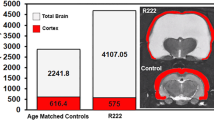Summary
The present study sought to determine whether differential effects could be found in the free behavior of early-operated monkeys with selective removal of the dorsolateral and orbital prefrontal cortex. The early-operated monkeys were first observed in their home cages in stable living groups which had existed for at least 6 1/2 months (together condition) and then again immediately after they had been separated from one another (separated condition). The major results indicated that the monkeys with orbital lesions differed from unoperated controls in more ways than did the dorsolateral monkeys: in the together condition, the orbital group slept more and were more sedentary even when awake; in the separated condition, by contrast, they became hyperactive and spent most of their time in locomotion. These findings lend support to the notion, derived from studies of cognitive behavior in infant-operated monkeys, that functions of the orbital cortex, unlike those of the dorsolateral cortex, are not spared following brain damage in infancy. Further, the nature of the behavior exhibited by the impaired monkeys led to the suggestion that the orbital cortex may play an important role in modulating arousal mechanisms in the infant and adult monkey alike.
Similar content being viewed by others
References
Akert, K., Orth, O.S., Harlow, H.F., Schiltz, K.A.: Learned behavior of rhesus monkeys following neonatal bilateral prefrontal lobotomy. Science 132, 1944–1945 (1960).
Brutkowski, S., Mishkin, M., Rosvold, H.E.: Positive and inhibitory motor CRs in monkeys after ablation of orbital or dorsolateral surface of the frontal cortex. In: Central and Peripheral Mechanisms of Motor Functions, pp. 133–141. Ed. by E. Gutman. Czechoslovakia: Academy of Sciences 1963.
Butter, C.M., Mishkin, M., Rosvold, H.E.: Conditioning and extinction of a food rewarded response after selective ablations of frontal cortex in rhesus monkeys. Exp. Neurol. 7, 65–75 (1963).
—, Snyder, D.R., McDonald, J.A.: Effects of orbital frontal lesions on aversive and aggressive behaviors in rhesus monkeys. J. comp. physiol. Psychol. 72, 132–144 (1970).
Butters, N., Rosvold, H.E.: Effect of caudate and septal nuclei lesions on resistance to extinction and delayed alternation. J. comp. physiol. Psychol. 65, 397–403 (1968).
Duncan, D.B.: Multiple range tests for correlated and heteroscedastic means. Biometrics 13, 164–176 (1957).
French, G.M.: Locomotor effects of regional ablation of frontal cortex in rhesus monkeys. J. comp. physiol. Psychol. 52, 18–24 (1959).
Goldman, P.S., Rosvold, H.E., Mishkin, M.: Evidence for behavioral impairment following prefrontal lobectomy in the infant monkey. J. comp. physiol. Psychol. 70, 454–463 (1970a).
—: Selective sparing of function following prefrontal lobectomy in infant monkeys. Exp. Neurol. 29, 221–226 (1970b).
Gross, C.G., Weiskrantz, L.: Some changes in behavior produced by lateral frontal lesions in the macaque. In: The Frontal Granular Cortex and Behavior, pp. 74–101. Ed. by J.M. Warren and K. Akert. New York: McGraw-Hill 1964.
Harlow, H.F., Blomquist, A.J., Thompson, C.I., Schiltz, K.A., Harlow, M.K.: Effects of induction age and size of frontal lobe lesions on learning in rhesus monkeys. In: The Neuropsyehology of Development, pp. 79–120. Ed. by R. Isaacson. New York: Wiley 1968.
Kennard, M.A., Spencer, S., Fountain, G.: Hyperactivity in monkeys following lesions of the frontal lobes. J. Neurophysiol. 4, 512–524 (1941).
Kling, A., Tucker, T.J.: Sparing of function following localized brain lesions in neonatal monkeys. In: The Neuropsychology of Development, pp. 121–145. Ed. by R. Isaacson. New York: Wiley 1968.
Ławicka, W., Mishkin, M., Rosvold, H.E.: Dissociation of impairment on auditory tasks following orbital and dorsolateral frontal lesions in monkeys. Proc. Cong. Polish Physiol. Soc. 10, 178 (1966).
Livingston, R.B., Fulton, J.F., Delgado, J.M.R., Sachs, E., Brendler, S.J., Davis, G.D.: Stimulation and regional ablation of the orbital surface of the frontal lobe. Research Publications Association for Research in Nervous and Mental Disease 27, 405–420 (1948).
Mettler, F.A.: Physiologic effects of bilateral simultaneous subcortical lesions in the primate. J. comp. Neurol. 81, 105–136 (1944).
Mishkin, M.: Perseveration of central sets after frontal lesions in monkeys. In: The Frontal Granular Cortex and Behavior, pp. 219–241. Ed. by J.M. Warren and K. Akert. New York: McGraw-Hill 1964.
—, Vest, B., Waxier, M., Rosvold, H.E.: A re-examination of the effects of frontal lesions on object alternation. Neuropsychologia 7, 357–364 (1969).
Nauta, W.J.H.: Some efferent connections of the prefrontal cortex in the monkey. In: The Frontal Granular Cortex and Behavior, pp. 397–409. Ed. by J.M. Warren and K. Akert. New York: McGraw-Hill 1964.
Richter, C.P., Hines, M.: Increased spontaneous activity produced in monkeys by brain lesions. Brain 61, 1–16 (1938).
Rosvold, H.E., Delgado, J.M.R.: The effect on delayed alternation test performance of stimulating or destroying electrically structures within the frontal lobes of the monkey's brain. J. comp. physiol. Psychol. 49, 365–372 (1956).
Ruch, T.C., Shenkin, H.A.: The relation of area 13 on orbital surface of frontal lobes to hyper-activity and hyperphagia in monkeys. J. Neurophysiol. 6, 349–360 (1943).
Tucker, T.J., Kling, A.: Differential effects of early and late lesions of frontal granular cortex in the monkey. Brain Res. 5, 377–389 (1967).
Velasco, M., Skinner, J.E., Asaro, K.D., Lindsley, D. B.: Thalamo-cortical systems regulating spindle bursts and recruiting responses. I. Effect of cortical ablations. Electroenceph. clin. Neurophysiol. 25, 463–470 (1968).
Author information
Authors and Affiliations
Additional information
Now at: Department of Psychiatry and Regional Primate Research Center, University of Washington Medical School, Seattle, USA.
Now at: Department of Biostatistics, Johns Hopkins University, Baltimore. Maryland, USA.
Rights and permissions
About this article
Cite this article
Bowden, D.M., Goldman, P.S., Rosvold, H.E. et al. Free behavior of rhesus monkeys following lesions of the dorsolateral and orbital prefrontal cortex in infancy. Exp Brain Res 12, 265–274 (1971). https://doi.org/10.1007/BF00237919
Received:
Issue Date:
DOI: https://doi.org/10.1007/BF00237919



